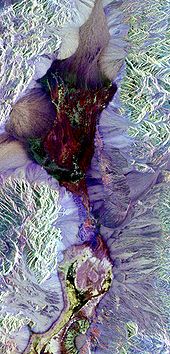Polarimetry
From Wikipedia, the free encyclopedia
Synthetic aperture radar image of Death Valley colored using polarimetry.
Contents
Applications
Polarimetry of thin films and surfaces is commonly known as ellipsometry.Polarimetry is used in remote sensing applications, such as planetary science and weather radar.
Polarimetry can also be included in computational analysis of waves. For example, radars often consider wave polarization in post-processing to improve the characterization of the targets. In this case, polarimetry can be used to estimate the fine texture of a material, help resolve the orientation of small structures in the target, and, when circularly-polarized antennas are used, resolve the number of bounces of the received signal (the chirality of circularly polarized waves alternates with each reflection).
Equipment
A polarimeter is the basic scientific instrument used to make these measurements, although this term is rarely used to describe a polarimetry process performed by a computer, such as is done in polarimetric synthetic aperture radar.Polarimetry can be used to measure various optical properties of a material, including linear birefringence, circular birefringence (also known as optical rotation or optical rotary dispersion), linear dichroism, circular dichroism and scattering.[3] To measure these various properties, there have been many designs of polarimeters. Some are archaic and some are in current use. The most sensitive polarimeters are based on interferometers, while more conventional polarimeters are based on arrangements of polarising filters, wave plates or other devices.
Astronomical polarimetry
Light given off by a star is un-polarized, i.e. the direction of oscillation of the light wave is random. However, when the light is reflected off the atmosphere of a planet, the light waves interact with the molecules in the atmosphere and they are polarized.[4]By analyzing the polarization in the combined light of an extrasolar planet and its star (about one part in a million), these measurements can in principle be made with very high sensitivity also on ground-based observatories, as polarimetry is not limited by the stability of the Earth's atmosphere. It is akin to transiting of a planet in front of its star.
Measuring optical rotation
Optically active samples, such as solutions of chiral molecules, often exhibit circular birefringence. Circular birefringence causes rotation of the polarization of plane polarized light as it passes through the sample.In ordinary light, the vibrations occur in all planes perpendicular to the direction of propagation. When light passes through a Nicol prism its vibrations in all directions except the direction of axis of the prism are cut off. The light emerging from the prism is said to be plane polarised because its vibration is in one direction. If two Nicol prisms are placed with their polarization planes parallel to each other, then the light rays emerging out of the first prism will enter the second prism. As a result, no loss of light is observed. However, if the second prism is rotated by an angle of 90°, the light emerging from the first prism is stopped by the second prism and no light emerges. The first prism is usually called the polarizer and the second prism is called the analyser.
A simple polarimeter to measure this rotation consists of a long tube with flat glass ends, into which the sample is placed. At each end of the tube is a Nicol prism or other polarizer. Light is shone through the tube, and the prism at the other end, attached to an eye-piece, is rotated to arrive at the region of complete brightness or that of half-dark, half-bright or that of complete darkness. The angle of rotation is then read from a scale. The same phenomenon is observed after an angle of 180°. The specific rotation of the sample may then be calculated. Temperature can affect the rotation of light, which should be accounted for in the calculations.
![[\alpha ]_{\lambda }^{T}=100\alpha /l\rho \,\!](https://upload.wikimedia.org/math/7/7/f/77f68ec427505915f1f16cdd405a6a4e.png)
where:
- [α]λT is the specific rotation.
- T is the temperature.
- λ is the wavelength of light.
- α is the angle of rotation.
- l is the length of the polarimeter tube.
 is the mass concentration of solution.
is the mass concentration of solution.
References
- Schmid, H. M.; Beuzit, J.-L.; Feldt, M.; et al. (2006). "Search and investigation of extra-solar planets with polarimetry". Direct Imaging of Exoplanets: Science & Techniques. Proceedings of the IAU Colloquium #200 1 (C200): 165–170. Bibcode:2006dies.conf..165S. doi:10.1017/S1743921306009252.
External links
- Polariscope - Gemstone Buzz instrument to measure optical properties.
- EU Project NanoCharM [1]
|
||||||||||||||||||||||||||||||||||||||||||||||||||||||||

No comments:
Post a Comment